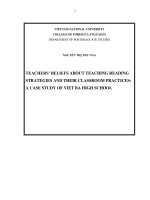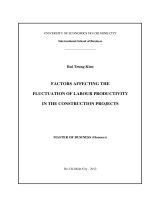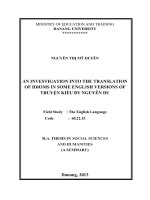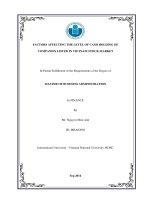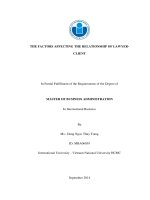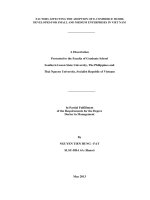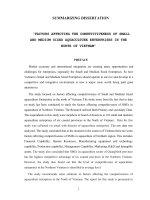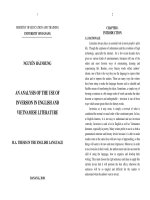an investigation into cultural factors affecting the translation of idioms from english into vietnamese
Bạn đang xem bản rút gọn của tài liệu. Xem và tải ngay bản đầy đủ của tài liệu tại đây (15.53 MB, 79 trang )
MINISTRY OF EDUCATION AND TRAINING
HANOI OPEN UNIVERSITY
M.A. THESIS
AN INVESTIGATION INTO CULTURAL FACTORS
AFFECTING THE TRANSLATION OF IDIOMS
FROM ENGLISH INTO VIETNAMESE
(NGHIÊN CỨU CÁC YẾU TỐ VĂN HÓA ẢNH HƯỞNG ĐẾN DỊCH
THÀNH NGỮ (ĐẶC NGỮ) TỪ TIẾNG ANH SANG TIẾNG VIỆT)
NGHIÊM THANH LỊCH
Hanoi, 2016
MINISTRY OF EDUCATION AND TRAINING
HANOI OPEN UNIVERSITY
M.A. THESIS
AN INVESTIGATION INTO CULTURAL FACTORS
AFFECTING THE TRANSLATION OF IDIOMS
FROM ENGLISH INTO VIETNAMESE
(NGHIÊN CỨU CÁC YẾU TỐ VĂN HÓA ẢNH HƯỞNG ĐẾN DỊCH
THÀNH NGỮ (ĐẶC NGỮ) TỪ TIẾNG ANH SANG TIẾNG VIỆT)
NGHIÊM THANH LỊCH
Field: English Language
Code: 60220201
Supervisor: Lưu Thị Phương Lan, PhD
Hanoi, 2016
CERTIFICATE OF ORIGINALITY
I, the undersigned, hereby certify my authority of the study project report
entitled AN INVESTIGATION INTO THE CULTURAL FACTORS
AFFECTING THE TRANSLATION OF IDIOMS FROM ENGLISH
INTO VIETNAMESE submitted in partial fulfillment of the requirements
for the degree of Master in English Language. Except where the reference is
indicated,
no
other
person’s
work
has
been
used
without
acknowledgement in the text of the thesis.
Hanoi, 2016
Nghiêm Thanh Lịch
Approved by
SUPERVISOR
Lưu Thị Phương Lan, PhD
Date: ………………..
due
ACKNOWLEDGEMENTS
First and foremost, I would like to express my deepest gratitude to my
supervisor, Dr. Luu Thi Phuong Lan. From the point of an advisor and a
mentor, she introduced and inspired me to do this research. My professional
development has been growing increasingly with her precious guidance and
continuous motivation.
I owe my family for their constant source of love, support and
encouragement. I am immensely grateful to them for standing behind me
whenever I needed them especially in times of difficulties.
I would also want to extend a special shout-out to all the research participants.
Without your valuable opinions and ideas on the questionnaires, the project
would not have been accomplished.
Finally, my special thanks go to all my dear friends for their understanding
and assistance during the process of preparing this research I count each of
you as my special blessings.
While I am greatly indebted to all of these people for their tireless help to my
completion of this thesis, I myself remain responsible for any inadequacies
that are found in this work.
ABSTRACT
The present study is a linguistics investigation of equivalence above word
level. It deals with the difficulties of non-equivalence emerged in translating
English idioms which encompass with cultural factors into Vietnamese
equivalents and the methods used by the second students to find the suitable
equivalent in the target language. The aim of this study is to examine the type
of difficulty students of the second-year have to face while translating idioms
and tries to suggest solutions and identify strategies that may help to limit or
avoid these difficulties. In this area, a questionnaire made up of twelve
English idioms is given to learners to be translated. The results of the study
show that there are potential problems in the process of translating idioms
from English into Vietnamese. Furthermore, the findings indicate that the
context of use helps learners much in guessing the appropriate meaning of
idioms. They also reveal that, except word for word translation, the learners’
use of other translation strategies is limited.
ABBREVIATION
ELF: English as a foreign language
ESL: English as a second language
SL: Source language
TL: Target language
LIST OF TABLES AND FIGURES
Table 1: Percentage of students’ familiarity and unfamiliarity with English
idioms ......................................................................................................... 35
Table 2: Frequency of student’s familiarity with the four categories of English
idioms .......................................................................................................... 39
TABLE OF CONTENTS
CERTIFICATE OF ORIGINALITY........................................................... i
ACKNOWLEDGEMENTS ......................................................................... ii
ABSTRACT ................................................................................................. iii
ABBREVIATION ....................................................................................... iv
LIST OF TABLES AND FIGURES ............................................................ v
CHAPTER I ................................................................................................. 1
INTRODUCTION ........................................................................................ 1
1.1. Rationale .............................................................................................. 1
1.2. Aims of the research ............................................................................. 2
1.3. Objectives of the research..................................................................... 2
1.4. Scope of the research ............................................................................ 2
1.5. Significant of the research .................................................................... 2
1.6. Structural organization of the thesis...................................................... 3
CHAPTER II ................................................................................................ 4
LITERATURE REVIEW ............................................................................ 4
2.1. Previous studies .................................................................................... 4
2.2. Theoretical background ........................................................................ 5
2.2.1. An overview of English idioms ......................................................... 5
2.2.1.1. Definitions of English idioms ......................................................... 6
2.2.1.2. Features of English idioms ............................................................. 7
2.2.1.2.1. Syntactic features......................................................................... 7
2.2.1.2.2. Semantic features....................................................................... 12
2.2.2. An overview of translation .............................................................. 16
2.2.2.1. Definitions of translation .............................................................. 16
2.2.2.2. Features of translation .................................................................. 17
2.2.2.2.1. Types of translation ................................................................... 17
2.2.2.2.2. Criteria ...................................................................................... 18
2.2.3. The translation of idioms ................................................................. 19
2.2.4. Characteristics of English culture and Vietnamese culture............... 20
2.2.4.1. Characteristics of English culture – individualist cultures ............. 20
2.2.4.2. Characteristics of Vietnamese culture – collective cultures........... 21
2.2.5. Categories of English and Vietnamese idioms according to cultural
characteristics ............................................................................................ 23
2.2.5.1. Religions and beliefs .................................................................... 23
2.2.5.2. Living circumstance ..................................................................... 24
2.2.5.3. Historical allusion......................................................................... 26
2.2.5.4. Traditions and customs ................................................................. 27
2.3. Summary ............................................................................................ 29
CHAPTER III ............................................................................................ 30
METHODOLOGY ..................................................................................... 30
3.1. Research-governing orientations ........................................................ 30
3.1.1. Research questions .......................................................................... 30
3.1.2. Research setting............................................................................... 31
3.1.3. Research approaches ....................................................................... 32
3.1.4. Principles/ criteria for intended data collection and data analysis .... 32
3.2. Research methods ............................................................................... 32
3.2.1. Major methods and supporting methods .......................................... 32
3.2.2. Data collection techniques ............................................................... 33
3.2.3. Data analysis techniques .................................................................. 33
3.3. Summary ............................................................................................ 34
CHAPTER IV............................................................................................. 35
FINDINGS AND DISCUSSIONS.............................................................. 35
4.1. Findings ............................................................................................. 35
4.1.2. Data analysis ................................................................................... 35
4.1.2.1. Translation of de-contextualized English idioms into Vietnamese 35
4.1.2.2. Analysis ........................................................................................ 37
4.1.2.3. Translation of English idioms into Vietnamese within the context of
use and cultural elements .......................................................................... 38
4.1.2.4. Results .......................................................................................... 41
4.1.2.5. Students’ strategies while translating English idioms ................... 44
4.2. Discussions ........................................................................................ 45
4.2.1. Difficulties in interpreting English idioms into Vietnamese from
cultural dimensions ................................................................................... 45
4.2.1.1. Recognition of idioms in cultural context ..................................... 46
4.2.1.2. Lack of equivalence in the target language ................................... 48
4.2.2. The direction of translation from English idioms into Vietnamese
from cultural dimensions ........................................................................... 49
4.2.2.1. Using an idiom of similar meaning and form (Total equivalence) 50
4.2.2.2. Using an idiom of similar but dissimilar form (Partial Equivalence)
.................................................................................................................. 51
4.2.2.3. Translation by paraphrase (Paraphrasing) ..................................... 52
4.2.2.4. Translation by omission................................................................ 53
4.2.3. Implications for idioms teaching and translation.............................. 53
4.2.3.1. Grouping idioms ........................................................................... 54
4.2.3.2. Explaining how idioms are motivated ........................................... 54
4.2.3.3. Introducing idioms in context ....................................................... 54
4.3. Summary ............................................................................................ 55
CONCLUSION........................................................................................... 56
5.1. Recapitulation .................................................................................... 56
5.2. Concluding remarks ........................................................................... 56
5.3. Limitations of the current research ..................................................... 57
5.4. Recommendations/ Suggestions for further research .......................... 58
REFERENCES ........................................................................................... 59
APPENDIX 1 .............................................................................................. 64
APPENDIX 2 .............................................................................................. 67
CHAPTER I
INTRODUCTION
1.1. Rationale
The English language is particularly noted for its wealth of idioms - those
ways of expressions peculiar to the dialect of a language that frequently
disobey logical as well as grammatical rules. Idioms are always one of the
most precious parts among cultural heritages. An idiom not only carries the
information they want to convey, but also expresses the special language
pleasant impression. Thus, translating English idioms is not only an interlingual communication, but a cross-cultural transfer, which involves a
comparative study of the source language culture and target language culture.
They let the readers think deeply in the spirit they contain. Sometimes some
English idioms are similar to Vietnamese idioms, then it is easy to translate
them into Vietnamese. But most of the time, they are quite different from
Vietnamese idioms, there is no corresponding terms exist, and then we should
take some means into consideration. It is the fact that translation is viewed
primarily as an inter-culture communication (Bassnett & Lefevere, 1990). As
can be seen from the discussion above, translation of idioms from English
into Vietnamese equivalents with reference to cultural factors is a large area
full of challenge. In the frame work of this study, the author only concentrates
on the English idioms filled with cultural identities. Since the research is
carried out against the Vietnamese backgrounds, the corresponding
Vietnamese equivalents are also provided. The study is so entitled An
investigation into the cultural factors affecting the translation of idioms from
English into Vietnamese.
1
1.2. Aims of the research
The aim of this study is investigating cultural factors affecting the translation
of idioms from English into Vietnamese in order to improve the idiomatic
translation skill of learners of Faculty of English in Hanoi Open University.
1.3. Objectives of the research
As an exploratory study of idiomatic translation from the perspective of
culture, this thesis pursued the following goals:
Describing the characteristics of English idioms and Vietnamese
idioms.
Pointing out the common difficulties which learners usually have to
face with while translating English idioms into Vietnamese.
Suggesting implications for translating idioms from English into
Vietnamese in terms of cultural perspectives.
1.4. Scope of the research
Academic scope
This study only concentrates on translating idioms from English language into
Vietnamese in the light of English culture and Vietnamese culture.
Social scope
The research also covers cultural aspects of the translation of idioms for the
second-year students from Faculty of English in Hanoi Open University.
1.5. Significant of the research
Theoretically, this research sets a comprehensive understanding of the
translation of idioms, attach much importance to cultural factors.
Practically, this research also provides English idioms containing cultural
factors that are shaped in their Vietnamese to help learners appreciate the
influence of cultural elements on the linguistic materials of English idioms as
well as Vietnamese translation. It expects to fulfill the shortcomings in
2
translating idioms from English into Vietnamese, which would help learners
at Hanoi Open University to translate them more effectively.
1.6. Structural organization of the thesis
The thesis is designed with five chapters as follows:
Chapter 1 is the introduction that gives the overview of the thesis including
rationale, aims, objectives, scope, significance and the organization.
Chapter 2 is the literature review that provides the recapitulation of several
previous studies and builds up fundamental features of idioms and idiomatic
translation.
Chapter 3 is the methodology that indicates the ways of seeking and
translating cultural specificities from English idioms and Vietnamese.
Chapter 4 is the findings and discussion that shows difficulties and strategies
in translating English idioms into Vietnamese equivalents.
Chapter 5 is the conclusion that summarizes the major findings of the thesis
with proper strategies, the limitations of the study and the suggestions for
further study.
References and Appendix come at the end of the study.
3
CHAPTER II
LITERATURE REVIEW
2.1. Previous studies
Other research works related to the theme under study before the current
thesis.
The study by Liu (2012) expressed his point of view that culture plays a vital
role in translating idioms from English into his mother tongue - Chinese
equivalences. He explained more about the differences between Chinese and
Western cultures in order to find out the highest possible degree of cultural
exchange through translating. In general, this research focused on the effects
that culture has on translation may help to disclose the aspects of translation
that the literarily-based and linguistically-based translation theories have
failed to do. Without a systematic study of translation and culture, any soclaimed theoretical system of translation studies is incomplete. This
contribution focuses on the handling of idioms and will shed light on the
translation of other cultural specificities. It is intended to usher in further indepth study of relations between culture and translation.
Ren and Yu (2013) also succeed in highlighting characteristics of idioms as
well as the importance of cultural context in determination of word-meaning –
the coral system theory of the thesis. Authors also suggested a range of useful
ways for correct comprehension of idioms meaning. They divided the
translation of idioms into four types based on translation principles of idioms,
namely all corresponding English and Chinese idioms and literal translation,
half corresponding English and Chinese idioms and adapted translation,
uncorresponding English and Chinese idioms and free translation, notation
translation. They pointed out and claimed English idioms are the production
4
of culture. Idioms are limited by English culture and have exclusive
characteristics
of
it,
contain
adequate
cultural
substance.
Hence,
understanding English idioms has to take culture into full consideration. This
study recommended the link between culture and language in relation with the
translation of idioms. It is encouraged researchers in further study of crosscultural transfer or intercultural communication through idiomatic translation.
In these studies, the authors have examined several issues which focus
attention on the translation of idioms between English and Chinese. Basically,
idioms are regarded as a form of language reflecting culture in a concentrated
way, therefore, the translation of idioms should be done from cultural
perspective firstly. Cultural factors are also mentioned in both researches. In
Liu’s opinion, he shows readers the importance of culture in translating
idioms, however, he have not explained the factors that make the differences
between the two languages. Additionally, Ren and Yu intended to investigate
the translation of idioms from communicative approaches. They put idioms in
practical cultural contexts. Thus, the translation of idioms is cross-cultural
communication. However, particular cultural factors which have great
influence on translation still have not been discussed.
In the present study, an idiom will be investigated in two main aspects. The
first one is the cultural way it is formed (cultural factors) and the second one
is the proper translation of it in context in order to ensure that its meaning fit
in Vietnamese culture (translation strategies). It hopes to make the views of
other researchers clearer as well as put the cultural factors in the right place
when translating English idioms into Vietnamese.
2.2. Theoretical background
2.2.1. An overview of English idioms
5
2.2.1.1. Definitions of English idioms
It is said that a language is a living substance, which evolves under the
influence of different factors. Over the past 600 years, English has grown
from a language of few speakers to become the dominant language of
international communication. Being very flexible, English language
constantly enriches its vocabulary with the words invented by the native
speakers, adding more colorful with new idiomatic expressions called
“idioms”; and from time to time, refills it stocks with the borrowings and
neologisms.
English, itself, just amazes by its peculiar linguistic diversity; in which, as
mentioned, idioms hold a notable position. As an authentic material in
English language, idioms are akin to a special flavor which season with newfangled and unique combination of words, inspire appetite for discovering and
learning.
To have an adequate overview of this linguistic phenomenon, numerous
authors study and bring forth reliable definitions of idioms.
Particularly, “an idiom is a group of words whose meaning is different from
the meanings of the individual words” (Oxford Advanced Learner’s
Dictionary, 2007). According to Dr. Chitra F. (1996), “Idioms are indivisible
units whose components cannot be varied or varied only within definable
limits”. From Langacker’s perpective, he also believes “An idiom is a kind of
complex lexical item. It is a phrase whose meaning cannot be predicted from
the meanings of the morphemes it comprises”. In his turn, Michael C.,
(2003:3) says that “Idioms are fixed expressions whose meanings is not
immediately obvious from looking at the individual words in the idioms”.
Albeit linguistics have different ways to define idioms, it is remarkable that
6
they refer to idiom with two main features, its constituent elements (syntactic)
and meaning (semantic).
Generally speaking, idioms are explained as relatively stable phrases whose
meanings are not deduced from the literal meanings of the words which make
them up in the dictionary. These characteristics make English idioms like
“hard nut to crack” for learners using English as the second language, “The
use of idioms is a challenge for English language learners because, compared
to standard vocabulary acquisition, understanding these expressions is not
clear by simply referring to a dictionary”, says Holleman (2006:45).
It can be seen that idioms are particular pattern of a language that the meaning
of an idiom is based on characterization of a person or a group of itself.
Hence, English learners usually get confused or stuck when finding the
meaning of a certain idiom. They cannot acquire the meaning of an idiom by
working out the meanings of separate components but rather by considering it
as a whole.
2.2.1.2. Features of English idioms
On the view adopted here, the creation of an idiom involves two parallel
mechanisms, one syntactic and the other semantic.
2.2.1.2.1. Syntactic features
Set-expressions
To commence with, in term of syntactic features, an idiom is a set-expression.
Thus, it is not easy for us to change the fixed order of an idiom. We can take
the idiom ‘spick and span’ as an example. The idiom means clean and tidy. If
we change it into ‘span and spick’, the idiom would make nonsense.
7
Professor Kunin (2006:45) states, “Idioms have lexical and grammatical
stability. It implies that they are fixed in their form, hence any substitution
and rearranging in their structure can lead to complete loss of their primary
meaning”.
Various structures
According to Kunin, idioms can be in form of noun phrase, verb phrase,
adjective phrase, prepositional phrase and adverb phrase with function as
noun, verb, adjective, preposition, and adverb, as follow:
Noun (N)
• N + N: ‘donkey work’ (hard work), ‘crocodile tears’ (insincere tears)
• N’s + N: ‘donkey’s years’ (in a long time), ‘lion’s share’ (the biggest
part)
• N + prep + N: ‘a flash in the pan’ (a success that only lasts a short
time)
• N + Adj: ‘hair-raising’ (terrifying), ‘bigheaded’ (conceited, boastful)
• N + and + N: ‘a cat and dog life’ (a person in a family frequently or
constantly quarreling), ‘neck and neck’ (stand by, next).
• Adj + N: ‘red tape’ (unnecessary bureaucracy), ‘black spot’ (a place in
a road where accidents often happen).
• N + S.Cl: ‘dogs that chase many hares kill none’ (unfaithfully love)
Verb (V)
• V + N: ‘hold water’ (suitable), ‘pop the question’ (make a proposal of
marriage).
8
• V + and + V: ‘hit and miss’ (carelessly, without plan or direction)
• V + (one’s) + N + prep: ‘glance one’s eyes down’ (take a very quick
superficial look at something)
• V + one + N: ‘eat one’s words’ (admit one was wrong)
• V + S.Cl: ‘see which way the wind blows’ (see what most people think,
or what is likely to happen before you decide how to act).
Adjective (Adj)
• Adj + and + adj: ‘fair and square’ (fairly), ‘hard and fast’ (difficult
rules)
• Adj + as + N: ‘as silent as the grave’ (very quiet), ‘as good as gold’
(helpful, well-behave).
Preposition (Prep)
• Prep + N: ‘in the pink’ (healthy and happy), ‘in vain’ (without success)
• Prep + N + prep: ‘in charge of’ (have responsibility), ‘in favour of’
(support)
Adverb (Adv)
• Adv + and + adv: ‘more and less’ (almost, nearly)
• Prep + N + or + Prep + N: ‘by hook or by crook’ (by any method,
whether it is honest or not).
• Conj + Cl: ‘when pigs fly’ (impossible to happen).
• Adv + prep + N: ‘once in a blue moon’ (very rarely).
Grammatical features
9
In connection with structure, an idiom can have a regular, an irregular or even
a grammatical incorrect structure. In his research, Cruse (2000:34) says,
“Idioms and idiomatic expressions do not follow standard grammatical rules,
mainly because of the fact that their elements do not have any meaning”. In
other words, idioms usually violate grammar rules. Also, Cruse points out
grammatical features of idioms via an example idiom ‘kick the bucket’
(meaning to die):
• Elements are not separately modifiable
Mr. Lee kicked the bucket.
Mr. Lee kicked the old bucket.
• Idioms can be modified only as a whole unit
Mr. Lee kicked the bucket unexpectedly.
• Elements do not coordinate with genuine semantic constituents
Mr. Lee kicked and punched the bucket.
Mr. Lee kicked the bucket and the pail.
• Elements cannot take contrastive stress or be the focus of topicalizing
transformations, and the like.
It was bucket what Mr. Lee kicked.
What Mr. Lee did to bucket was kick it.
• Elements cannot be referred back anaphorically
Mr. Lee kicked the bucket. Jack kicked it, too.
• An idiom does not survive the substitution of any of its constituent
elements by a synonym or a near synonym
10
Mr. Lee kicked the pail.
Mr. Lee pulled his sister’s arm.
Accordingly, Baker (1992:63) provides a list of what a speaker or writer
cannot do with an idiom:
• To change a word order:
Sound and safe.
‘Safe and sound’
• To delete a word:
‘The apple of one’s eye’
The apple of one’s.
• To add a word:
‘Let the cat out of the bag’
Let the cat out of the beautiful bag.
• To replace a word with another:
‘Sell like hot cakes’
Sell like hot bread.
• Change its grammatical structure:
‘Caught a cold’
Catch a cold.
However, as some other idioms are more flexible than others, we can make
some changes if idioms do not lose their idiomatic meanings. As in the idiom
‘spill the beans’ (give secret), we possibly use it in several different tenses
and its individual constituents can be replaced or referred to utilizing a
pronoun. If this idiom is used in a question like “Who spilled the beans?”, the
tense has been altered. The question might be the answered with “They were
spilled by Ethel”; therefore, replacing the beans with pronoun that refers back
to the ‘beans’ in the question. This means that idioms are only in some of
their part, but not all.
11
Recognition
An idiom is the special chemical mixture of all components, which is
completely in new quality. From that, Bell (1974:2) remarks some critical
syntactic features of idioms for learners to realize them easily.
Firstly, he mentions alteration of grammatical rules as one of identities. The
idiomatic expressions are not always grammatical, but they are established,
accepted and utilized by native speakers of the language with a fixed structure
and meaning. For example, “It’s ages since we met” (singular with a plural
noun).
Secondly, conventional phrase is taken into account. Idioms are extraordinary
sayings which are almost known and admitted by all the members of a
specific community. To illustrate, the idiom ‘smell a rat’ (to become
suspicious, to suspect that something is wrong) or ‘the last straw’ (the final
problem or difficulty in a series of problems), just only are realized and
absorbed by the people in the same culture.
Last but not least, alteration of word order is considered. In English idioms,
the word order is usually violated. Let’s have a look at the examples:
• It may be well ahead of time (normal word order).
• It may well be ahead of time (probably – idiomatic expression).
That is to say, syntactic features of idioms are relatively diverse from fixed
phrases to structural forms with prominent characteristics. Each of these
factors combines with others harmoniously to affect idioms’ formation.
2.2.1.2.2. Semantic features
Idioms are integral units. It literally means that idioms possess indivisible
completeness, so all the components are bound within one idiom.
12
Literal and figurative meanings
Literal and figurative meanings are two possible meanings of all idioms.
Albeit, in most cases, the literal meaning is illogical because idioms often do
not obey standard rules of syntax and semantic. This is why Glucksberg
(2001:69) states that “There is generally no logical relation between an idiom
and its semantic meaning, idioms may be seen as long ordinary words, whose
semantics are indiscriminate and learned by memorizing”. There are some
typical illustrations:
The idiom ‘stick to one’s gun’ is used when you want to talk about a person
who always maintains his or her opinion. Such as in the sentence, “Kate
always sticks to her gun in all discussions”, if the audience understand this
situation by its literal meaning, they may feel it seems ridiculous.
Similarly, the idiom ‘a veritable couch potato’ is usually used to talk about a
very lazy person, not anything relates to the dish “potato”.
Likewise, ‘have got egg on one’s face’ does not mention “real egg”, it means
someone has made a fool.
The above examples direct the meanings of idioms cannot be derived from the
component words as well as they vary from the same as that of the set phrase.
Positive, neutral and negative meanings
One more semantic feature of idioms is that they feasibly convey positive,
neutral or negative meanings.
A majority of idioms have a positive meaning, in particular, ‘head and
shoulders over the others’ (better than others), ‘go like a bomb’ (very
successful), ‘whole-hearted’ (helpful, generous, well-behave), etc.
13
Idioms with neutral meaning such as ‘by and large’ (in general), ‘short and
sweet’ (talk in short way), ‘to watch the world go by’ (to observe happening
events while doing nothing), etc.
Negative idioms also take a part with a range of comments about people or
thing, namely ‘all fingers and thumbs’ (very clumsy, awkward), ‘pigheaded’
(stubborn), ‘cooking the books’ (cheat in working), ‘take you for a ride’
(cheat someone) and so on.
To put it simply, all above instances are justify for the diverse and
complicated meanings of idiomatic expressions.
Types of idioms based on semantic meanings
A. V. Kunin (2006) emphasizes “Idioms as a stable combination of word with
a fully or partially figurative meaning”. This idea mentions two inherent and
important features of the idiomatic expressions.
Genuinely, researchers interested in idioms have tried to classify them into
different kinds according to the degree of idiomaticity that an idiom carries.
Semantically, idioms are categorized in a continuum from transparent to
opaque called the spectrum of idiomaticity. Therefore, idioms can be divided
into four sections:
Transparent idioms
Transparent idioms are those idioms that can be move easily derived. These
idioms have a very close meaning to that of the literal one. Hence, transparent
idioms are usually not difficult to understand and translate, because their
meanings can be easily inferred from the meanings of their constituents, both
components have a direct meaning but the combination acquires figurative
sense (Fernando, 1996).
14
